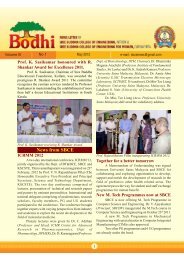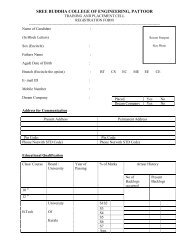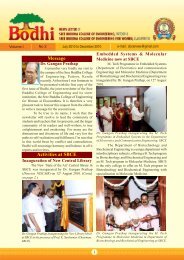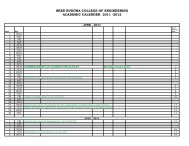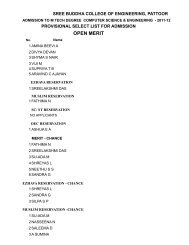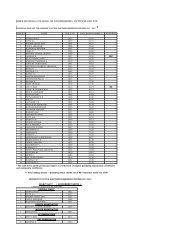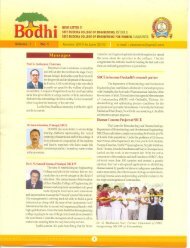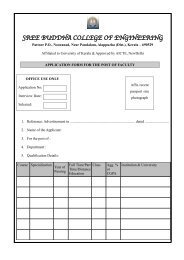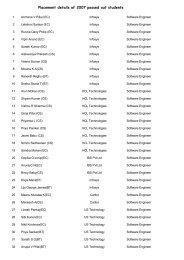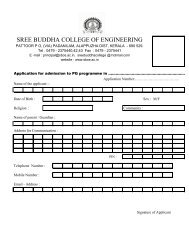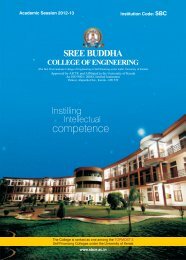UNIVERSITY OF KERALA
UNIVERSITY OF KERALA
UNIVERSITY OF KERALA
Create successful ePaper yourself
Turn your PDF publications into a flip-book with our unique Google optimized e-Paper software.
model and dispersion model)- estimation of biochemical conversion using these models- application of dispersion<br />
model to design of continuous sterilizers – design of novel bioreactors- packed bed bioreactors, Bubble-column<br />
bioreactors, fluidized bed bioreactors, trickle bed bioreactors, airlift loop bioreactors, photobioreactors,- Key issues in<br />
bioreactor design and operation -alternate bioreactor configurations- bioreactor dynamics- stability analysis in<br />
bioreactors- nontrivial and wash out steady states.<br />
MODULE II<br />
Mass transfer in bioprocessing systems: Gas liquid mass transfer- volumetric oxygen transfer coefficientcorrelations<br />
(Cooper correlation, Oldshue correlation, Yamamoto correlation, Yoshida correlation, Richards<br />
correlation) – oxygen transfer mechanism- assessment of K L a- chemical method, dynamic differential gassing out<br />
method, dynamic integral gassing out method, oxygen balance method, enzymatic method- merits and demerits of each<br />
method.<br />
Scale up and scale down of bioprocess systems: Need for scale up and scale down- operating boundaries for aerated<br />
and agitated fermenters- scale up criteria for microbial cell processes- constant power input per unit volume, constant<br />
K L a, constant mixing quality, constant momentum factor, constant impeller tip speed, constant mixing rate numberscale<br />
up example with flow chart- scale down procedure.<br />
Monitoring and Control of Bioprocesses:<br />
Fermentation monitoring: Various physical, chemical and biological parameters measured or controlled in<br />
bioreactors-Physical and chemical sensors for fermentation medium and gases- online sensors for cell properties-offline<br />
analytical methods- measurement of medium properties and cell population composition- flow cytometry.<br />
Analysis by Microfluidics: Basic principles of flow based analytical techniques, flow injection, sequential injection,<br />
Bead injection and Sequential injection chromatography- methods and applications.<br />
Measurement analysis: Use of digital computers for data acquisition, interpretation and analysis- software systemsdata<br />
smoothing and interpolation –Fault analysis- state and parameter estimation methods- use of observers or<br />
estimators.<br />
Process control: Open loop and closed loop control-direct regulatory control, cascade control of metabolismprogrammed<br />
control- application of artificial intelligence in bioprocess control-knowledge based expert systems, neural<br />
networks (A brief overview of the above is only required).<br />
Bioprocess modeling and simulation: Structure of bioprocess models- concept of balance domain- model validation<br />
using MATLAB- objectives and benefits of bioprocess simulation-simulation tools such as SIMULINK, Biopro<br />
Designer, Biotechnology Design Simulator and Bioprocess Simulator.<br />
MODULE III<br />
Medium engineering for cell cultivation and bioreaction: Technological concerns of medium design engineering in<br />
bioprocessing-design procedure for growth and production medium- stoichiometric design approach- bioorganic<br />
reaction medium engineering- Novel media.<br />
Immobilized cell systems: Potential advantages of cell immobilization, methods of active and passive immobilizationdiffusional<br />
limitations in immobilized enzyme systems-bioreactor considerations.<br />
Bioprocess considerations in using plant and animal cell cultures: Methods for cultivation of animal cellsrequirements<br />
for culturing of animal cells-bioreactor design considerations- perfusion systems-products of animal cell<br />
cultures- importance of plant cell cultures-comparison of plant cell and microbes in culture-bioreactor considerations<br />
for suspension cultures, immobilized systems and organ cultures- products of plant cell cultures<br />
Bioprocess systems for genetically engineered organisms: Basic elements of genetic engineering, genomics and<br />
bioinformatics- guidelines for choosing host-vector systems-comparison of strategies-genetic instability in recombinant<br />
cell cultures- segregational loss, plasmid structural instability, host cell mutations, growth rate dominated instabilityconsiderations<br />
in plasmid design to avoid process problems- simple mathematical model for prediction of genetic<br />
instability- regulatory constraints on genetic processes- outline of metabolic engineering and protein engineering with<br />
simple case studies.<br />
Medical applications of bioprocess engineering: overview of tissue engineering-commercial tissue culture processesgene<br />
therapy using viral vectors-use of bioreactors as artificial hybrid organs and for mass production of cells for<br />
transplantation.<br />
REFERENCES<br />
1. Pauline. M. Doran, Bioprocess engineering principles, Academic press.1995.<br />
2. James. E.Bailey, David.F. Ollis, Biochemical engineering fundamentals, Second edition, McGraw Hill.1986.<br />
3. Michael. L.Shuler, Fikret Kargi, Bioprocess Engineering- Basic concepts ,second edition, Prentice Hall of<br />
India.2002.<br />
4. Colin Ratledge and Bjorn Kristiansen, Basic Biotechnology, Second edition, Cambridge university<br />
press.2001.<br />
5. Mukhopadhyay S.N, Process Biotechnology fundamentals, 2 nd edn. Viva Books<br />
40



